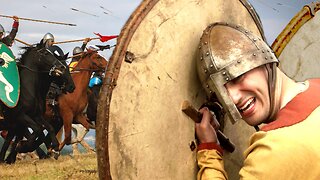Premium Only Content

Part-1 History Tomb of Fatima Masuma (A) روضہ مبارک حضرت فاطمہ معصومہ سلام اللہ علیہا کی تاریخ
@islamichistory813 #ShrineOfLadyFatimaMasuma #IslamicHistory #QomShrine
The History of Shrine of Lady Hazrat Fatima Masuma (A)
Part-1
Asslamoalaikum sisters brothers friends and elders, Today we are describing in This video provides a comprehensive overview of the history and significance of the Shrine of Lady Fatima Masuma (AS) extracted from the renowned Al-Islam organization site. Learn about the life of Lady Fatima Masuma (AS), the sister of Imam Reza (AS), and the establishment of her shrine in the holy city of Qom, Iran. Gain insight into the cultural, religious, and architectural aspects of this revered pilgrimage site.
After the burial of Lady Fatima Masuma (A), Musa ibn Khazraj placed a ceiling made of wicker over the grave, which remained unchanged until Zaynab, daughter of Imam al-Taqi (A), came to Qum and had a dome built on the grave.1 The dome was built of bricks and mortar. This event occurred in the middle of the third Islamic century.
After the passing of some time, two other domes were built near the first dome and it was under the third dome that Zaynab, daughter of Imam al-Taqi (A) was herself buried.
These three domes remained till the year 457 A.H, when the vizier of Tughrul the Great, Mir Abu al-Fadl al-Iraqi, at the urging of the great scholar, Shaykh Tusi (d.460 A.H) built one high dome in place of the three domes.
3.2 - During the reign of the Safavids
From the time of the replacement of the three domes by one, until the time of the reign of the Safavids,2 the condition of the shrine of Lady Fatima Masuma (A) remained somewhat the same. At this time there was no chamber above the grave, nor any porches or courtyards.
In the year 925 A.H Shah Ismail I built a gold porch on the North side and laid the foundation of what is now called the old courtyard. After him, Shah Tahmasb I, built a burial chamber, with glazed tiles, around the holy grave. He also built a porch on the South side of the grave (in the old courtyard).
In the year 1077 A.H Shah Safiy built a courtyard for women, in the south of the threshold of the grave, which is now the area surrounding the enclosed area of the Mosque of Tabatabai. This courtyard is the burial place for Shah `Abbas and Shah Sulayman and Shah Sultan Husain.
In the time of the reign of Shah `Abbas, the burial chamber was covered with white steel and the present chamber contains some of the same steel with sheets of silver added to it.
3.3 - During the reign of the Qajars
After the reign of the Safavids, further repairs to the shrine of Lady Fatima Masuma (A) did not take place until the time of the reign of the Qajars in Iran.3
In the year 1218 A.H Fath Ali Shah Qajar made a dome of gold using 12000 gold-covered bricks. In the year 1236 A.H, the mosque known as Masjid-e B?l? Sar [the mosque at the head of the holy body of Lady Fatima Masuma (A)], was built.
In the year 1276 A.H, the porch of Shah Ismail Safavi was decorated with gold and in the year 1275 A.H the steel burial chamber of Shah `Abbas was remade using silver.
Towards the end of the 13th century A.H, the foundation for a new, bigger courtyard was laid, and the building was completed during the reign of Nasir al-Din Shah, in the year 1303 A.H.4
3.4 - After the victory of the Islamic Revolution
During the course of its history, a lot of elegant and beautiful decorative work, using different materials and scripts has been added to the shrine of Lady Fatima Masuma (A), which we are unable to go into in this book.
After the victory of the Islamic Revolution of Iran, the leader, Grand Ayatollah Khomeini, authorised a number of important changes to the layout and organisation of the holy shrine. More facilities for pilgrims were introduced. The Masjid-e Adam, built by the Grand Ayatollah Burujadi, was annexed to the holy shrine. The shrine was enlarged and currently this expansion project is continuing. Other changes were also been made, but again the details lie outside the scope of this book.
3.5 - The construction of the burial chamber to the present time
In the year 605 A.H, Amir Ahmad ibn Ismail commissioned the leading glass tile-maker and engraver of the time, Muhammad ibn Abi Tahir Kashikar Qummi, to decorate the tomb of Lady Fatima Masuma (A). The work was completed in 8 years.
In the year 950 A.H, Shah Tahmasb Safavi, erected a burial chamber made of bricks and decorated with tiles of seven colours, around the tomb. The chamber had a screen through which pilgrims could see the tomb and put in donations and petitions into the chamber.
After some years, by the order of Shah `Abbas, a steel grill was placed in front of the bricked burial chamber.
In the year 1230 A.H, Fath Ali Shah Qajar, covered this steel grill with silver. This remained in place until it showed signs of deterioration and in the year 1280 A.H, a new chamber, using silver from the old one, as well as additional silver from the treasury, was erected, entirely replacing the old one.
This new chamber remained for a long time over the tomb of Lady Fatima Masuma (A), being repaired as needed, until the year 1368 A.H. Then, by the order of the Custodian of the time, a newer burial chamber, with a different shape was erected in place of the former one.
After over 40 years, due to the increase in the numbers of visitors to the holy shrine, and natural deterioration, the grills of the burial chamber became corroded.
Additionally, the wooden interior of the chamber, which had been in place for over a hundred years, had become badly damaged. More importantly, the constant washing of the chamber with rose water had given it a red tinge, and cracks were found in its foundations. The considerable damage to the chamber necessitated a replacement.
The custodian of the shrine, Ayatollah Masudi, made the decision in the year 1415 A.H to replace the burial chamber. For this purpose, the leading expert in the field, Agha Husain Parwaresh Isfahani was commissioned to design a new chamber. He died before he could finish the work and it was completed by Agha Muhammad Husain `Abbaspur Isfahani.
So friends today we are stoping to describe history of Shrine Fatima Masuma (AS) here and remaining history will be described in second part InshaAllah tomorow same time. Allah Hafiz.
============================
-
 11:49
11:49
Reforge Gaming
2 hours agoXbox - Next Game on PlayStation?
9.8K3 -
 27:46
27:46
ArturRehi
1 day agoSurprise Counter-Attack in Kursk Advanced 3 Miles | French Jets Arrive | Ukraine Update
3.95K4 -
 11:51
11:51
Alabama Arsenal
14 hours ago $1.23 earnedThe Silent Sledgehammer | GQ Armory 8.6BLK Paladin
52.7K1 -
 2:21:11
2:21:11
Nerdrotic
17 hours ago $38.53 earnedDown the Rabbit Hole with Kurt Metzger | Forbidden Frontier #090
185K35 -
 2:41:13
2:41:13
vivafrei
23 hours agoEp. 251: Bogus Social Security Payments? DOGE Lawsduit W's! Maddow Defamation! & MORE! Viva & Barnes
281K309 -
 1:19:23
1:19:23
Josh Pate's College Football Show
16 hours ago $5.35 earnedBig Ten Program Rankings | What Is College Football? | Clemson Rage| Stadiums I Haven’t Experienced
81.9K1 -
 13:22:09
13:22:09
Vigilant News Network
21 hours agoBombshell Study Reveals Where the COVID Vaccine Deaths Are Hiding | Media Blackout
137K69 -
 1:17:59
1:17:59
Sarah Westall
17 hours agoDOGE: Crime & Hysteria bringing the Critics & the Fearful - Plus new CDC/Ukraine Crime w/ Dr Fleming
128K16 -
 45:39
45:39
Survive History
23 hours ago $12.40 earnedCould You Survive in the Shield Wall at the Battle of Hastings?
105K7 -
 1:50:28
1:50:28
TheDozenPodcast
21 hours agoViolence, Abuse, Jail, Reform: Michael Maisey
132K7